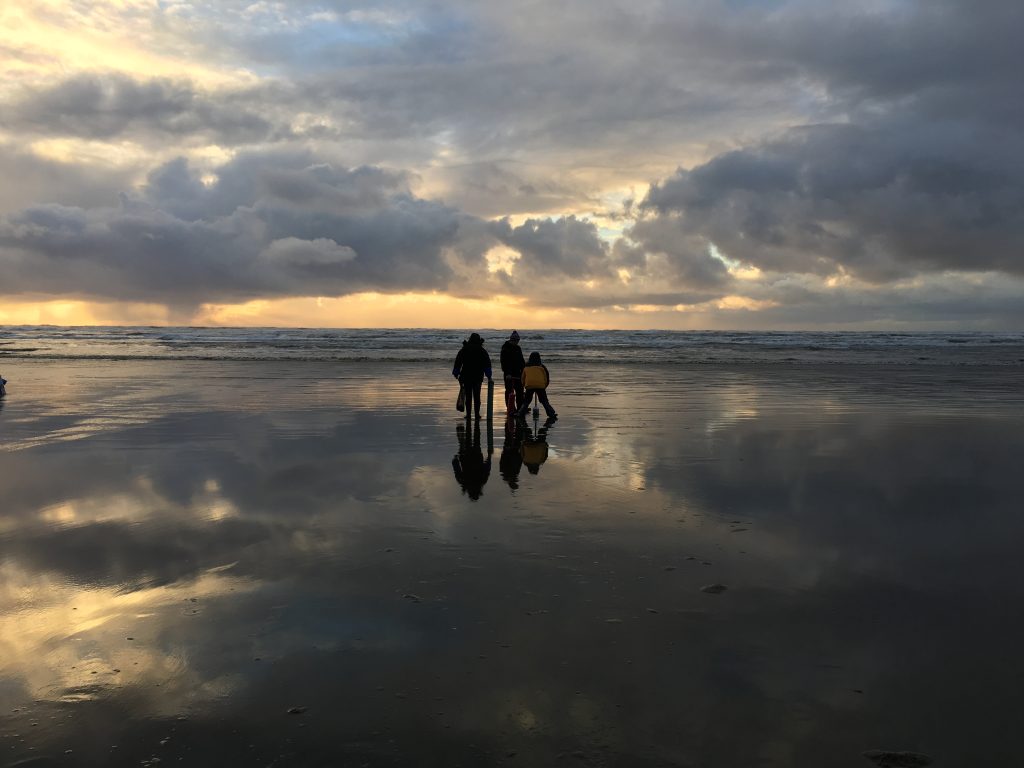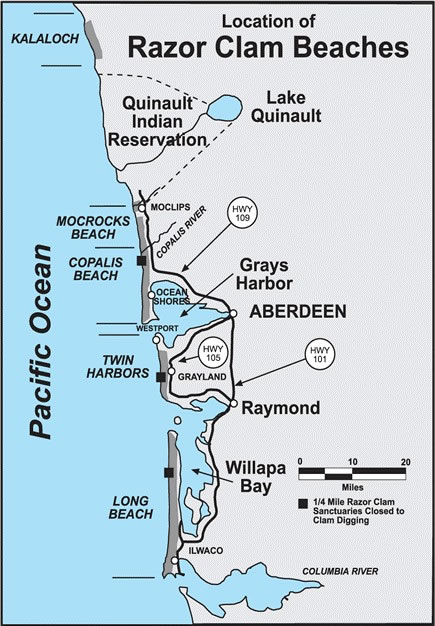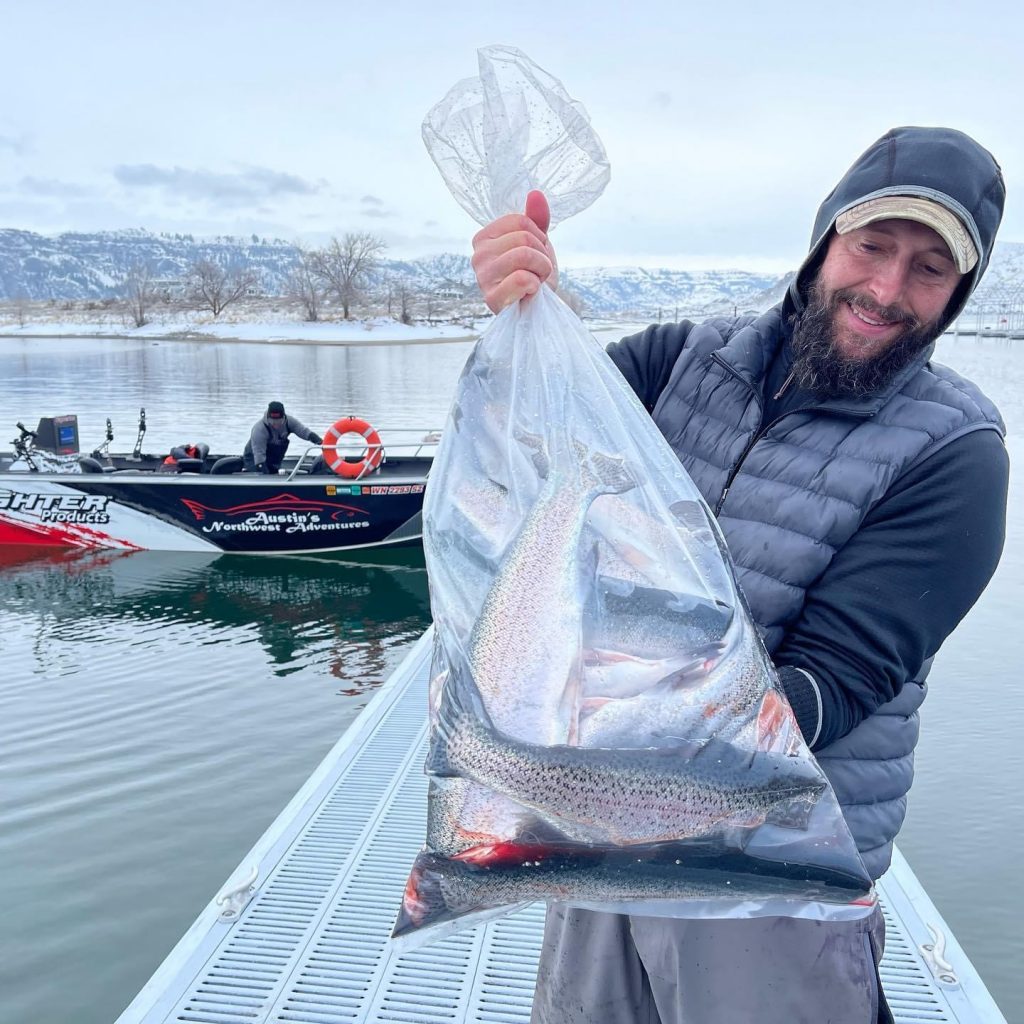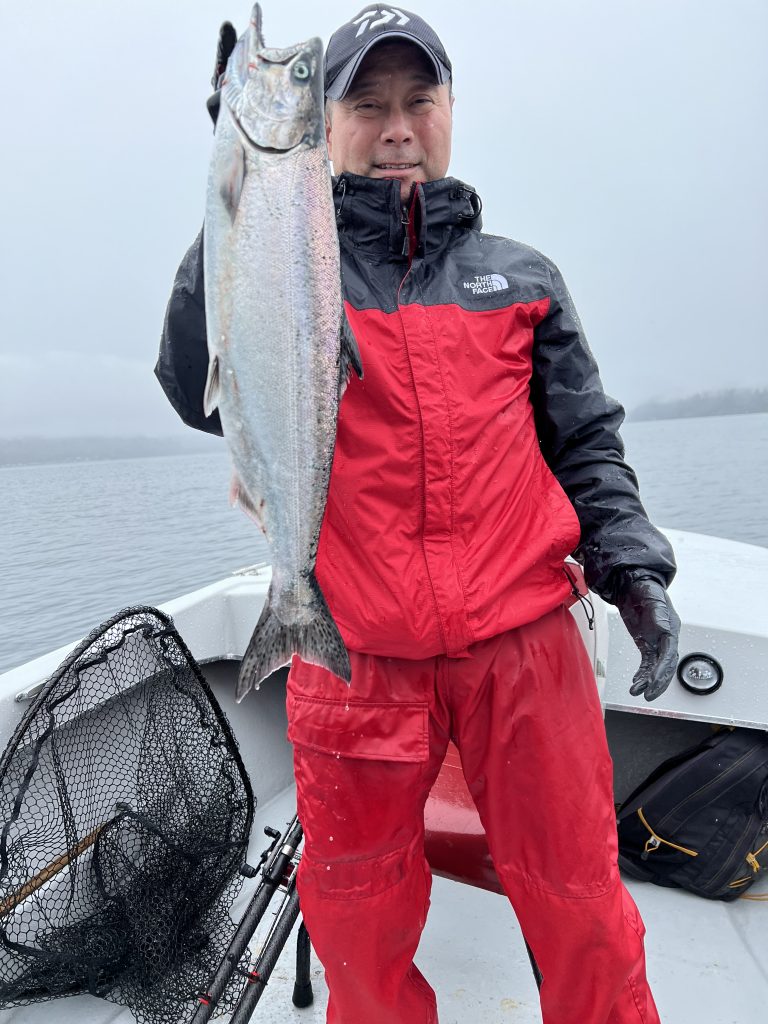Escape winter doldrums by heading to the coast for razor clams or east of the Cascades for big rainbow trout as well as other fun fisheries in between Leave a reply

Contributed by Mark Yuasa, WDFW
Don’t let the wintery weather stop you from getting out and wetting a line as a wide range of fishing activities are happening right now that are well worth the effort of layering up in some warm clothes.
This includes gathering a nice batch of razor clams off the coast, chasing winter chinook in southern Puget Sound, hooking into a trophy-sized rainbow trout in north-central Washington and busting through the ice in some eastern Washington lakes.
The good times continue to roll along the surf line off the coast as the next series of razor clam digs get underway today (Friday, Jan. 14).
“Even though it was a little cold, the digs on (Dec. 31-Jan. 1) drew more than 15,000 diggers to the coast,” said Dan Ayres, the Washington Department of Fish and Wildlife (WDFW) coastal shellfish manager said in a news release. “Each digger took home an average of 14.5 clams.”

Digs allowed during evening low tides only are Friday (Jan. 14) at Long Beach; Saturday (Jan. 15) at Long Beach, Twin Harbors and Copalis; Sunday (Jan. 16) at Long Beach, Twin Harbors and Mocrocks; Monday (Jan. 17) at Long Beach, Twin Harbors and Copalis; Tuesday (Jan. 18) at Long Beach and Twin Harbors; Wednesday (Jan. 19) at Long Beach and Copalis; and Thursday (Jan. 20) at Long Beach.
The daily limit is the first 15 clams dug regardless of size or condition. Each digger’s clams must be kept in a separate container.
During the most recent digs from Dec. 30 to Jan. 5 a total estimate of 9,134 diggers at Long Beach had 125,535 clams for 13.9 clams per person daily average; 5,814 at Twin Harbors had 82,294 for 14.2; 3,424 at Copalis had 47,345 for 13.8; and 3,583 at Mocrocks had 49,691 for 13.9.
Coast-wide since the season began on Sept. 17 a total of 67 days of digging has occurred with 251,926 diggers taking home 4,450,600 razor clams.
More tentative dates for razor clam digs pending final marine toxin testing are – Jan. 29, and Feb. 2 at Long Beach, Twin Harbors and Mocrocks. Feb. 1, 18 and 26 at Long Beach, Twin Harbors and Copalis. Jan. 20 and 31, and Feb. 14 and 28 at Long Beach only. Feb. 3 at Copalis only. Feb. 17 at Long Beach and Twin Harbors only. Jan. 30, and Feb. 16 at Long Beach and Copalis only. Feb. 15 and 27 at Long Beach and Mocrocks only. If marine toxins remain low, it is likely WDFW will set additional dates for digging clear into springtime.
Note: Not all beaches are open for every dig, so diggers are encouraged to make sure their intended destination is open before heading out.
Those willing to travel safely over the Cascade mountains will be rewarded with numerous places to catch trout and many other fish species.

Those seeking an enjoyable rod bending experience should look no further than Rufus Woods Reservoir where the winter-time rainbow trout fishery is in full swing.
Many of the trout caught are averaging 2 to 6 pounds along with some even larger along a broad 51-mile area from Bridgeport to Coulee Dam. The best success usually occurs around the three net pens.
Rocky Ford Creek north Moses Lake was stocked with hundreds of rainbow trout averaging 2 to 6 pounds.
“Rocky Ford Creek never freezes over and is always a good catch-and-release fly-fishing only location,” said Chad Jackson, a WDFW biologist.
In recent days the weather has warmed up in central and eastern Washington between the mid-30s and low 40s so those planning on doing some ice fishing on lakes should be cautious of thinning ice.
The Northwest Ice Fishing Festival is this Saturday from 8 a.m. to 3 p.m. at Okanogan County’s Sidley Lake (elevation 3,683 feet) in Molson. Last year, anglers weighed in 72 trout totaling more than 67 pounds. Most trout average 12-inches with a few hitting 4 pounds. Sidley was planted in October with close to 14,000 trout.
Be sure to stop by for the Molson Grange Pancake Breakfast between 7 a.m. and 10 a.m. To register, go to https://www.eventbrite.com/e/nw-ice-fishing-festival-registration-226344030087 or call 509-557-5165.
Fish Lake north of Leavenworth is a popular place for ice fishing with a mix of rainbow trout and yellow perch. The lake has a strong yellow perch population, and you might even catch a kokanee too.
Roses Lake near Lake Chelan is a good location for rainbow trout, and many will find fish just off the boat launch casting Power Bait.
Other Okanogan County lakes worth a try for ice fishing are Rat, Patterson Bonaparte, Leader and Upper and Lower Green for trout and a mix of yellow perch, crappie, and bluegill.
Many will use small jigs laced with a maggot, but dough baits, nightcrawlers, eggs and marshmallows also do the job.
Other essential ice fishing gear includes an auger, short rod with spinning reel and a five-gallon plastic bucket with a cushion to rest on. Many will bring a sled to haul their gear.
Safety is always used when ice fishing, and it is common sense to fish with a buddy. Usually about 4 to 8 inches of ice is safe to walk on. Stay away from places on lakes covered with snow and ice that was thawed and then refrozen.
Word on marine winter chinook fishery
Saltwater salmon anglers were gearing up to head out the central Puget Sound (Marine Catch Area 10), but WDFW fishery managers decided late Thursday to temporarily suspend the winter chinook fishing season until further notice.

The three-day-a-week fishery opened on Jan. 1-3 with low effort due to the inclement weather although a fair catch of hatchery-marked winter chinook occurred on the opener. This past Saturday through Monday (Jan. 8-10) saw improved turnout and a higher catch ratio of 0.6 to 0.25 fish per rod average.
Estimates of landed winter chinook through Jan. 10 was 2,054 fish or 24 percent of the total encounters (8,475 guideline); 1,797 fish or 25 percent of sublegal encounters (7,319), which are fish under the 22-inch minimum size limit; and 514 fish or 46 percent of unmarked encounters (1,105).
Many anglers supported a priority for preserving fishing opportunity for February and March. Therefore, the fishery originally open Saturdays through Mondays only until March 31 with a one hatchery-marked chinook daily limit has hit the pause button.
WDFW will continue analyzing the fishery data collected in ongoing test fishing and plans to meet with the Puget Sound sport-fishing advisory board to decide on a reopening date.
In the meantime, your sole option is southern Puget Sound (Area 13) south of the Narrows Bridge, which is open year-round but has seen slow action for hatchery chinook of late.
Places to look for winter chinook are Point Gibson near the “Big Rock” on the southeastern shore of Fox Island; Fox Point on northeastern side; the Fox Island public fishing pier (commonly referred to as the concrete dock); and downrigger trollers can find success along the northern side in Hale Passage.
In deep South Sound try Johnson Point, Point Fosdick, Anderson Island, Lyle Point, Budd Inlet and Devil’s Head.
(Mark Yuasa is a Washington Department of Fish and Wildlife Communications Consultant and longtime contributor to ESPN 710 KIRO The Outdoor Line. He also was the fishing and hunting reporter at The Seattle Times for 28 years.)

